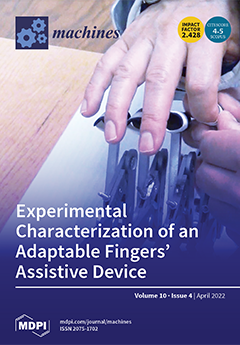Machines, Volume 10, Issue 4 (April 2022) – 64 articles
Describes the design and validation of an Adaptable Fingers’ Assistive Device
• It consists of four slider-crank mechanisms. Each slider-crank moves one finger (from the index to the little finger).
• The mechanism can execute the motion of any finger by adjusting the length of one single link.
• Experimental tests have been carried out to validate the feasibility and effectiveness of the proposed device. View this paper
- Issues are regarded as officially published after their release is announced to the table of contents alert mailing list.
- You may sign up for e-mail alerts to receive table of contents of newly released issues.
- PDF is the official format for papers published in both, html and pdf forms. To view the papers in pdf format, click on the "PDF Full-text" link, and use the free Adobe Reader to open them.





